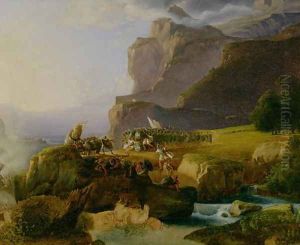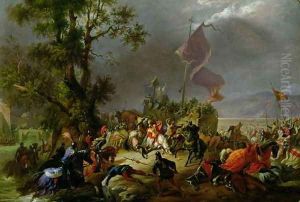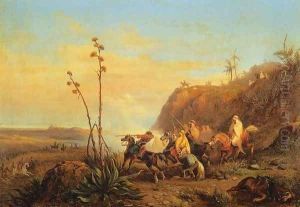Massimo Taparelli d' Azeglio Paintings
Massimo Taparelli, Marquis d'Azeglio, born in Turin on October 24, 1798, was a prominent Italian statesman, novelist, painter, and intellectual. He played a significant role in the Risorgimento, the movement for Italian unification. D'Azeglio was born into an aristocratic family, his father being the Marquis Cesare d'Azeglio, and he was exposed to politics and culture from a young age. He initially pursued a military career, which he abandoned for the arts, particularly literature and painting.
As a painter, d'Azeglio was initially self-taught and later studied under Martin Verstappen in Milan. His artistic work mainly consisted of landscape paintings, which were influenced by the Romantic movement. His paintings were appreciated for their poetic and sentimental qualities, which reflected his involvement with the Romantic literary circle of the time.
In literature, d'Azeglio gained fame with his historical novels, such as 'Ettore Fieramosca' (1833) and 'Niccolò de' Lapi' (1841), which were inspired by the works of Sir Walter Scott. These novels were not only significant literary achievements but also served as patriotic propaganda, aiming to inspire a sense of national identity among Italians.
Transitioning from the artistic to the political sphere, d'Azeglio became actively involved in politics. He was a proponent of moderate liberal reforms and opposed both the reactionary policies of the Austrian Empire and the radical revolutionary movements. He supported a united Italy under a constitutional monarchy and was an ally of the more famous statesman Camillo di Cavour.
D'Azeglio's political career included serving as the Prime Minister of the Kingdom of Sardinia from 1849 to 1852. During his tenure, he worked on the reform of the civil code and judiciary, and he strove to mediate between the various political factions of the time. He also played a part in the events leading up to the unification of Italy, though he eventually disagreed with some of Cavour's methods and policies.
Despite his political involvement, d'Azeglio continued to engage with the arts and literature throughout his life. He wrote essays on art, history, and culture, and he remained an influential figure in Italian intellectual circles until his death in Pisa on January 15, 1866. His legacy is that of a Renaissance man who contributed significantly to the culture, politics, and unification of his country.


